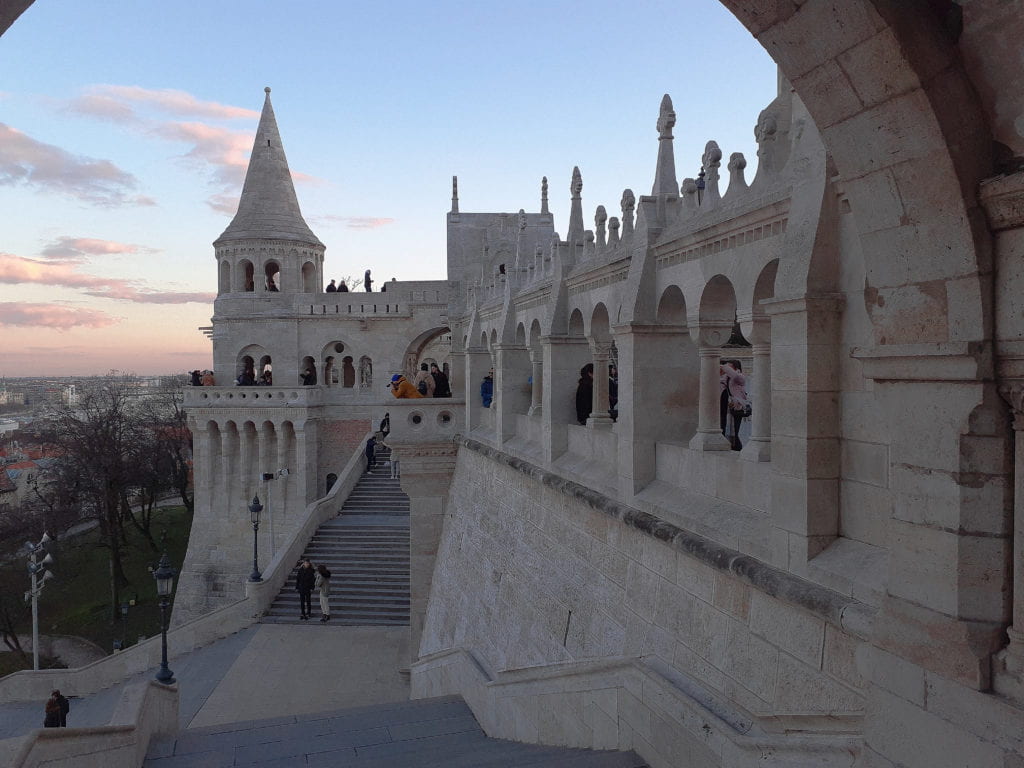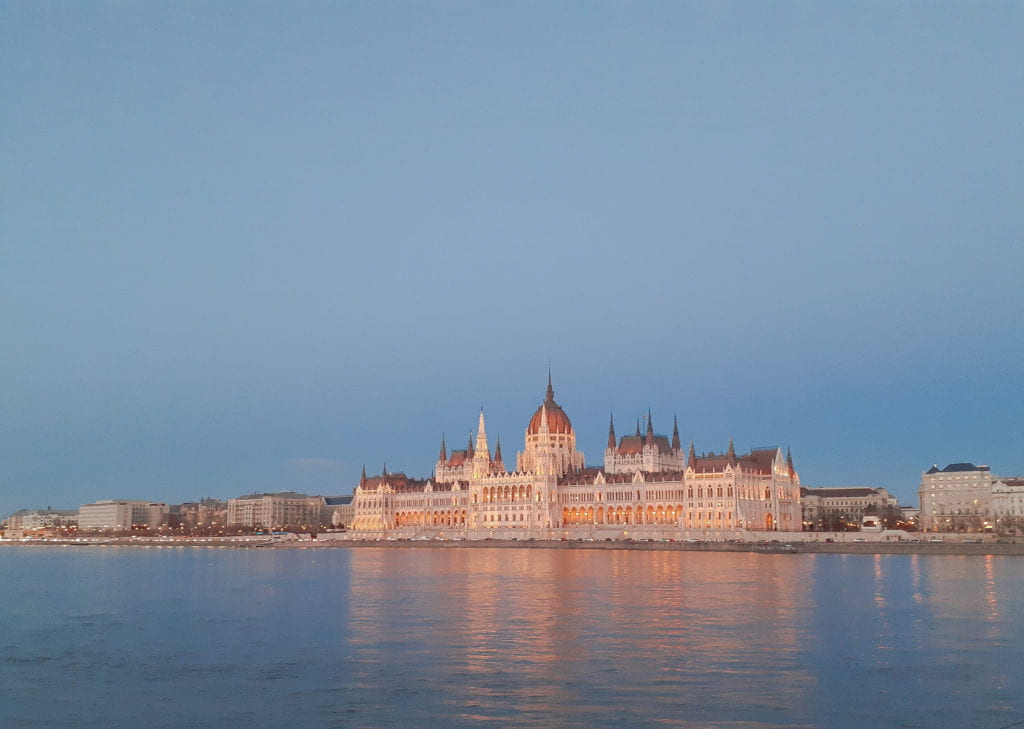Friday, May 15th, 2020 | Written by Blanca
*Disclaimer: This story takes place in February before the travel restrictions and shelter in place mandates.*
George Ezra’s 2014 smash hit single “Budapest,” off his first studio album Wanted on Voyage, begins with the lines,
“My house in Budapest
My hidden treasure chest.”
Ezra then goes on to detail the finery and treasures of his purported residence in Budapest before proclaiming that, believe it or not, he would leave the beauty of his home and the hard work put into acquiring it all behind in order to be with the object of his affection. Listening to this song in 2014, I’d simply thought that Ezra had put a lot of time into curating home décor and buying the many “acres of a land” on which it all sat, but that these were insignificant compared to the feelings he held for the person for whom “Budapest” is meant. Clearly, I was formally more naïve. After traveling to Budapest for 3 days toward the end of GT-Lorraine’s spring break in February, I now realize that the song was in fact an ardent declaration of love to someone for whom the magnitude of Ezra’s feeling transcended even his love for Budapest, unequivocally one of the most marvelous cities in the world, much less his prime piece of real estate located there. When my three days were up, I even seriously contemplated just how bad it would be if I didn’t leave (very bad, I concluded), and I had been staying in a single room of an Airbnb which was rather lackluster compared to the estate George Ezra describes. The person for whom “Budapest” was written must’ve been a pretty extraordinary (an understatement, if you’ve also seen Budapest) individual to have warranted a song of its nature.
While George Ezra certainly writes catchy tunes, I jest; “Budapest” was not why I traveled to the capital of Hungary. I’d simply wanted to see the city for myself, and had wanted to for a number of years, so after a brief stint in Prague, I took a 6-hour train into Hungary. I arrived at Budapest Nyugati station, located on the Pest side of Budapest (I’ll elaborate more on this in a bit), as the skies began to darken.
Fun fact! Nyugati was built by the Eiffel Company, the same firm behind the eponymous Eiffel Tower.
Although I later learned that the interior of the station, even its strangely baroque McDonald’s, were as grand as its exterior, I regrettably didn’t loiter for long. I had promised to meet my Airbnb host in front of the rental at 5PM, which was fast approaching; besides, after hearing a bit of Hungarian over the train intercom upon arrival and realizing it made no sense to me whatsoever—unlike the languages of countries in western Europe, those of eastern Europe have zero cognate words in English—I decided it was probably best for me to find my way before the sun dipped below the horizon entirely.
Sure enough, I found György (or George, as he introduced himself upon learning I spoke English), my Airbnb host, on the hour. Despite managing hundreds of properties and living 40 minutes away, he took the time to acclimate me to the Airbnb before sitting me down in the kitchen and showing me a map of Budapest aksing, “Had I ever been to Budapest before?” I replied that I hadn’t, but I’d heard much about it and was excited to see as much as I could of what already seemed to be a beautiful city. George seemed unimpressed by my lack of planning, (which I tried explaining that I’d intended to do that night) and gave me a much needed rundown of all things Budapest. He told me that Budapest is the amalgamation of formerly separate cities divided by the Danube River: Buda on the west, and Pest on the east. We were located in Pest, he told me, but I could easily get to the magnificent Buda Castle on the Buda side by crossing the Danube on the Széchenyi Chain Bridge, a sight that I ought not to miss. Castle Hill is extremely steep, so travelers can reach the Castle via funicular railway, although he found it to be unreasonably expensive; after giving me a once-over, George determined that in my young age, I’d probably enjoy the scenic hike up the hill anyway (spoiler: I did). Other attractions that George thought I should see were the Hungarian State Opera House, which I regrettably was unable to visit, St. Stephen’s Basilica, and the Heroes Square. If I had some more time, I could also visit the Royal Palace of Gödöllő in Pest county, which was the Hungarian residence of Empress Elisabeth of Austria. Elisabeth loved Budapest so much, George told me proudly, that she spent half the year at Gödöllő. It’s clear that Hungarians adore her just as much, because they affectionately refer to her by her nickname, Sisi.

After answering my concerns about riding the Budapest Metro, which I would be using in a few days’ time when I headed back to Metz—George informed me that the Budapest Metro was the among the oldest of functioning electric underground railways, second only to the London Underground, and also a breeze to use—George and I parted ways: he to his home, and I to a local coffee shop called Mon Chéri. Unlike most other non-nightlife establishments of continental Europe, which tend to close earlier in the evening, I was pleasantly surprised to find that coffee shops in Budapest stayed open much later, many until 11PM. While studying isn’t the most glamorous activity for a first night in Budapest, Physics 2 homework waits for no one, not even those who finally have a few precious days in a city they’ve yearned to visit for ages. A slice of tiramisu and a vanilla latte certainly helped to soften the blow.

The next morning, I set off, Google Maps in hand, for the Buda side of Budapest. Weaving through elegantly baroque avenues, I arrived at the banks of the Danube and crossed the Chain Bridge.

Stately Buda Castle perches atop the rather steep Castle Hill, but the sweeping views of the Danube, the Hungarian Parliament Building, and the rest of the city make the trek well worth it. Set on a site that was once home to Habsburgs, Ottomans, and Hungarian nobility alike, nowadays Buda Castle houses Magyar Nemzeti Galéria, or the Hungarian National Gallery, which shows off the works of Hungarian artists from the Middle Ages to contemporary times. To the surprise of absolutely nobody, I spent a handful of hours inside, wandering the U-shaped palace, marveling at its painting-adorned walls and its massive (and seriously impressive) collection of medieval wood altars. I found the National Gallery to be a particularly meaningful visit, because while many great Hungarian artists studied and worked in Paris and elsewhere in the west, the exhibited works weren’t copies of Italian Renaissance or French Impressionist styles as one might expect. Many seemed to me to be particularly somber and/or subtly distorted, as if they represented the struggles and unrest Hungary experienced throughout the centuries. Then again, my eye is also extremely untrained. Maybe Hungarian painters just liked to use the same kind of paint or something, but in any event, I came to realize that all the works in the museum shared an unobtrusive but decidedly Hungarian style.
At the time of my visit, the National Gallery was also showing a temporary exhibit on the life and works of Hungarian Jewish painter István Farkas, and while making my way through the chronologically-ordered gallery, I realized how his artwork reflected the progression of his life, of the hardships he faced as a Hungarian Jew. Farkas was a victim of the Holocaust, so it was hard to find optimism or beauty in any of the pieces upon reaching the end of the exhibit, but I immensely appreciated the level of curation that must have went into it. Through Farkas’ art, I understood the history of the diaspora in Hungary in a way that a history book probably couldn’t teach me (and indeed more than any of the history books, though few, I’ve ever read). Budapest is home to the largest synagogue in Europe and to a lively Jewish quarter, so the history of the Hungarian Jewish people is intertwined with the history of Hungary, and as a foreigner to Budapest and to the country as a whole, and as with any of my travels, I always appreciate the moments where I can more deeply understand the background of the particular place I am visiting.
The sun was beginning to dip by the time I departed Buda Castle. Luckily, my next destination was only a few cobblestone streets away. The neo-Romanesque Fisherman’s Bastion is an eye-catching landmark in itself, and it offered a gorgeous panorama of the sunset. I often find that my expectations of tourist attractions are too high, but my opinion of the Fisherman’s Bastion was (and still is) completely the opposite. The landmark reminded me almost of a fairytale sand castle, except the bastion’s towers were very real and quite permanent. But, like Cinderella rushing down the palace steps at the stroke of midnight, the setting sun meant that I soon needed to descend Castle Hill to return to my Airbnb.

Before crossing the Chain Bridge back to Pest, however, I stopped at the banks of the Danube to gaze at the Hungarian Parliament Building. GT-Lorraine students might recognize the Hungarian Parliament Building as the edifice that graces the front of the Eurail pass cover—I personally recognize it as the most beautiful building I’ve ever seen—but no pictures could possibly do the striking neo-Gothic exterior justice. I tried anyway, snapping a few photos before putting my phone away and watching the exterior light up, left to right, as the sky faded from pink to purple to blue.

